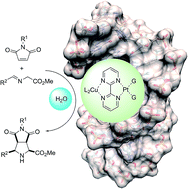当前位置:
X-MOL 学术
›
Chem. Sci.
›
论文详情
Our official English website, www.x-mol.net, welcomes your
feedback! (Note: you will need to create a separate account there.)
Catalysis of a 1,3-dipolar reaction by distorted DNA incorporating a heterobimetallic platinum(II) and copper(II) complex
Chemical Science ( IF 7.6 ) Pub Date : 2017-08-22 00:00:00 , DOI: 10.1039/c7sc02311a Iván Rivilla 1, 2, 3, 4, 5 , Abel de Cózar 1, 2, 3, 4, 5 , Thomas Schäfer 6, 7, 8, 9, 10 , Frank J. Hernandez 5, 8, 9, 10 , Alexander M. Bittner 5, 8, 9, 10, 11 , Aitziber Eleta-Lopez 8, 11, 12 , Ali Aboudzadeh 5, 8, 9, 10 , José I. Santos 3, 5, 8, 13 , José I. Miranda 3, 5, 8, 13 , Fernando P. Cossío 1, 2, 3, 4, 5
Chemical Science ( IF 7.6 ) Pub Date : 2017-08-22 00:00:00 , DOI: 10.1039/c7sc02311a Iván Rivilla 1, 2, 3, 4, 5 , Abel de Cózar 1, 2, 3, 4, 5 , Thomas Schäfer 6, 7, 8, 9, 10 , Frank J. Hernandez 5, 8, 9, 10 , Alexander M. Bittner 5, 8, 9, 10, 11 , Aitziber Eleta-Lopez 8, 11, 12 , Ali Aboudzadeh 5, 8, 9, 10 , José I. Santos 3, 5, 8, 13 , José I. Miranda 3, 5, 8, 13 , Fernando P. Cossío 1, 2, 3, 4, 5
Affiliation

|
A novel catalytic system based on covalently modified DNA is described. This catalyst promotes 1,3-dipolar reactions between azomethine ylides and maleimides. The catalytic system is based on the distortion of the double helix of DNA by means of the formation of Pt(II) adducts with guanine units. This distortion, similar to that generated in the interaction of DNA with platinum chemotherapeutic drugs, generates active sites that can accommodate N-metallated azomethine ylides. The proposed reaction mechanism, based on QM(DFT)/MM calculations, is compatible with thermally allowed concerted (but asynchronous) [π4s + π2s] mechanisms leading to the exclusive formation of racemic endo-cycloadducts.
中文翻译:

畸变DNA结合异双金属铂(II)和铜(II)配合物催化1,3-偶极反应
描述了一种基于共价修饰的DNA的新型催化系统。该催化剂促进了甲亚胺烷基化物和马来酰亚胺之间的1,3-偶极反应。催化系统基于DNA的双螺旋的变形,该结构是通过形成带有鸟嘌呤单元的Pt(II)加合物来实现的。这种畸变类似于DNA与铂化学治疗药物相互作用中产生的畸变,产生了可以容纳N-金属化的偶氮甲亚胺酰化物的活性位点。所提出的反应机理,基于QM(DFT)/ MM的计算,是与通向外消旋只形成热允许一致(但异步)[π4s+π2s]机制兼容内切-cycloadducts。
更新日期:2017-09-25
中文翻译:

畸变DNA结合异双金属铂(II)和铜(II)配合物催化1,3-偶极反应
描述了一种基于共价修饰的DNA的新型催化系统。该催化剂促进了甲亚胺烷基化物和马来酰亚胺之间的1,3-偶极反应。催化系统基于DNA的双螺旋的变形,该结构是通过形成带有鸟嘌呤单元的Pt(II)加合物来实现的。这种畸变类似于DNA与铂化学治疗药物相互作用中产生的畸变,产生了可以容纳N-金属化的偶氮甲亚胺酰化物的活性位点。所提出的反应机理,基于QM(DFT)/ MM的计算,是与通向外消旋只形成热允许一致(但异步)[π4s+π2s]机制兼容内切-cycloadducts。











































 京公网安备 11010802027423号
京公网安备 11010802027423号